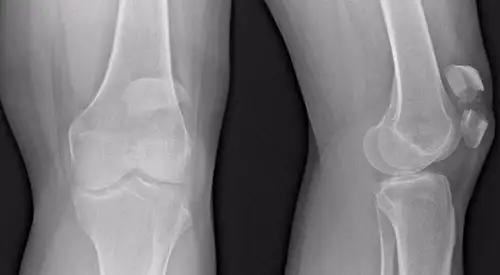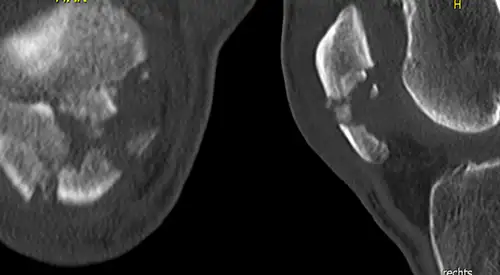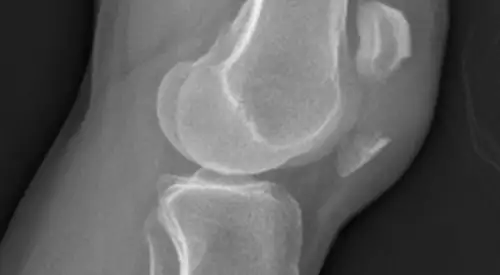Kneecap Fracture
"If the bone fragments are displaced, it is likely that you will need surgery for faster functional recovery".
DR. ANDRÉS VALENTÍ
SPECIALIST. ORTHOPEDIC SURGERY AND TRAUMATOLOGY DEPARTMENT

The kneecap is a bone vulnerable to fracture if it falls directly on the knee or is hit because of its location and little protection.
A kneecap or patella fracture is a serious injury that can make it difficult or even impossible to straighten the knee or walk.
Some simple patellar fractures can be treated with a cast or splint until the bone heals. However, in most patellar fractures, the bone fragments are displaced when the injury occurs. For these more complicated fractures, surgery is needed to restore and stabilize the kneecap and allow function to return.

Types of Kneecap Fractures
Types of patellar fractures:
Stable fracture. The fragments remain in contact with each other or are separated by a millimeter or two. In a fracture that allows conservative treatment with immobilization and discharge.
Displaced fracture. In a displaced fracture, the bone fragments are separated. This type of fracture often requires surgery to stabilize the fragments.
Comminuted fracture. In this type of fracture, the bone is broken into three or more pieces. Depending on the specific fracture pattern, a comminuted fracture may be stable or unstable.
Open fracture. In an open fracture, the bone is broken in such a way that bone fragments protrude through the skin or an injury penetrates to the bone.
An open fracture often involves damage to surrounding soft tissues and may take longer to heal.
Open fractures are particularly serious because, once the skin is broken, there is an increased risk of infection in both the wound and the bone. Immediate treatment is required to prevent infection.
Have you suffered a fractured kneecap?
Adequate treatment is important to prevent sequelae
How is a kneecap fracture diagnosed?
X-rays will help identify the kneecap fracture.
Sometimes it is necessary to request complementary tests (MRI or CT) to visualize the state of the cartilage or to observe the fracture in more detail.
How is patella fracture treated?
If the bone fragments are not displaced, placement of a cast or splint will keep the broken ends of the bone in the correct position while they consolidate.
Depending on your specific fracture, you may be allowed to put more or less weight on it.
However, with some fractures, weight bearing is not allowed for 6 to 8 weeks. Your physician will discuss weight-bearing restrictions with you.
If the bone fragments are displaced, you will most likely need surgery for faster functional recovery.
The procedure that is often performed is an osteosynthesis using a "figure eight" tension band or cerclage. Cerclage allows for compression over the fracture site and early mobilization.
Another alternative in transverse fractures is to stabilize the fragments once they have been reduced by means of small screws.
Comminuted fracture. In some fractures, the great destruction of the fragments may require their resection and the reconstruction of the kneecap and reinsertion of the patellar tendon on this smaller kneecap.
The removal of small portions of the kneecap that cannot be reconstructed can also have good results, although it sometimes causes loss of muscle strength.

Whether your treatment is surgical or non-surgical, rehabilitation will play a vital role in getting you back to your daily activities.
Because treatment for a patellar fracture may sometimes require keeping your leg immobilized in a cast for an extended period of time, your knee may become stiff and the muscles may atrophy.
During rehabilitation, your doctor or a physical therapist will provide you with specific exercises to improve range of motion, tone and decrease stiffness in your knee.
Your doctor will tell you when you can begin to put weight on your limb. Initially, the weight load is limited to gently touching your foot to the ground. As your injury heals and your muscles become stronger, you can gradually increase the load.
Recovery time after a patellar fracture will depend on several factors, including the severity of the injury. Most patients will be able to return to normal activities within 3 to 6 months.
Even after successful treatment, some patients with patellar fractures may experience long-term complications.
Post-traumatic Osteoarthritis: Even when bones heal normally, the articular cartilage that covers the bones can become damaged, causing pain and stiffness over time.
Muscle weakness: Some patients may have permanent weakness of the quadriceps muscle in the front of the thigh after a fracture. Loss of movement in the knee is also common.
Chronic pain: Long-term pain in the front of the knee is common with patellar fractures.
While the cause of this pain is not fully understood, it is likely to be related to post-traumatic osteoarthritis, stiffness and muscle weakness.
Where do we treat it?
IN NAVARRE AND MADRID
The Department of Orthopedic Surgery and Traumatology
of the Clínica Universidad de Navarra
The Department of Orthopedic Surgery and Traumatology covers the full spectrum of congenital or acquired conditions of the musculoskeletal system including trauma and its aftermath.
Since 1986, the Clinica Universidad de Navarra has had an excellent bank of osteotendinous tissue for bone grafting and offers the best therapeutic alternatives.
Organized in care units
- Hip and knee.
- Spine.
- Upper extremity.
- Pediatric orthopedics.
- Ankle and foot.
- Musculoskeletal tumors.

Why at the Clinica?
- Experts in arthroscopic surgery.
- Highly qualified professionals who perform pioneering techniques to solve traumatological injuries.
- One of the centers with the most experience in bone tumors.























